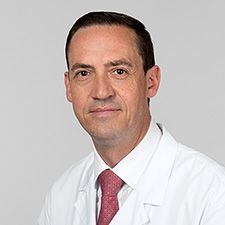Overview
Compared to other types of cancer, testicular cancer is rather rare. However, testicular cancer is the most common malignant cancer among 20 to 40-year-olds. In Switzerland, around 500 patients are newly diagnosed with a testicular tumor every year. In most cases, those affected notice a hardening and swelling of the testicles themselves, whereupon the appropriate diagnosis is made and, if confirmed, treatment is initiated.
Further information on testicular tumors, diagnosis and symptoms can be found here: Testicular cancer
Optimum care thanks to unique treatment
The excellent cure rates of this tumor disease are primarily based on adherence to the sometimes complex stage-adapted treatment guidelines. The certified Testicular Tumor Center of the University Hospital Zurich offers the platform for optimal care of testicular tumor patients with its interdisciplinary testicular tumor consultation and interdisciplinary tumor board, which is unique in Switzerland.
Urology treatment options
Testicular amputation / radical orchiectomy (“high inguinal ablatio testis”)
This is a surgical procedure in which the testicle is removed through an incision in the groin. This procedure is used in cases of suspected testicular cancer to expose and ligate the blood vessels and spermatic cord before the testicle is removed. Once the testicle has been removed, it is sent to a pathologist for histological examination, who confirms the diagnosis after carefully analyzing the tissue.
In some cases, the loss of a testicle can lead to a psychologically stressful situation. In such cases, a silicone testicular prosthesis can be an option to maintain or restore the aesthetic appearance of the scrotum and boost the patient’s self-confidence. This option is discussed with the patient before the procedure.
When a testicle is removed, the remaining testicle is examined for precancerous lesions in patients with a corresponding risk constellation. A testicular biopsy can help to detect a preliminary stage of testicular cancer called GCNIS (“germ cell neoplasia in situ”) and, if necessary, initiate complementary therapy (radiation) in good time in order to reduce the risk of new tumor growth on the opposite testicle. The procedure also helps to find out how well the opposite testicle can produce sperm. This makes it possible to estimate the patient’s future fertility.
Diagnostic surgery / histological frozen section examination
If anything is unclear, a tissue examination during the operation can help to confirm or rule out the diagnosis of a testicular tumor. Tissue is removed from the affected testicle and immediately examined under a microscope to determine whether it is benign or malignant and also what type of tumor it is. Only then is a decision made as to whether the tumor needs to be isolated or whether the testicle actually needs to be removed as a whole.
Testicle-preserving partial resection / partial orchiectomy
In the case of small testicular lesions that are visible with ultrasound without any noticeable tumor markers, testicle-preserving surgery may be sufficient. Only part of the testicle is removed. This decision can only be made during the operation. It is often advisable to carry out adjuvant (supportive) radiotherapy of the residual tumor after organ-preserving removal of the tumor.
Orchiectomy and sexuality
The removal of a single testicle (radical orchiectomy) usually has no effect on a man’s potency as long as the second testicle is healthy. The desire for sexuality (libido), erection, sexual experience, sperm production, orgasm and ejaculation as well as fertility generally remain unaffected.
For many patients, family planning has not yet been completed at the time of the illness. There is a rule of thumb that one third of men are unable to conceive before treatment, another third have problems during treatment (especially chemotherapy) but later recover, and the last third remain permanently infertile by natural means. Patients have the option of storing a frozen sperm reserve in liquid nitrogen (so-called “cryopreservation”) in case the treatment could affect fertility. This option is also discussed with patients prior to treatment.
The Department of Urology at the USZ works closely with the University Hospital of Cologne and its Clinic Director Prof. Dr. med. Dr. h.c. Axel Heidenreich. The Cologne Clinic for Urology is one of the second opinion centers accredited by the German Cancer Society and one of the European reference centers for the treatment of testicular germ cell tumors. We maintain a close clinical exchange in the treatment of complex cases (surgical planning and implementation), intensify cooperation in joint research projects in the field of testicular tumors and use Cologne’s expertise to expand professional excellence at the University Hospital Zurich site.
Testicular Cancer Center at the USZ
Treatment options: Active monitoring, surgery, chemotherapy and radiotherapy
A therapy tailored to the patient is discussed at the interdisciplinary tumor board with the involvement of all disciplines and their experts in order to find the optimal treatment for the respective tumor stage in consultation with the patient.
In addition to the initial surgical treatment (high inguinal ablatio testis), further therapeutic procedures such as percutaneous radiotherapy, additional chemotherapy and further operations (e.g. retroperitoneal lymphadenectomy) may be necessary.
